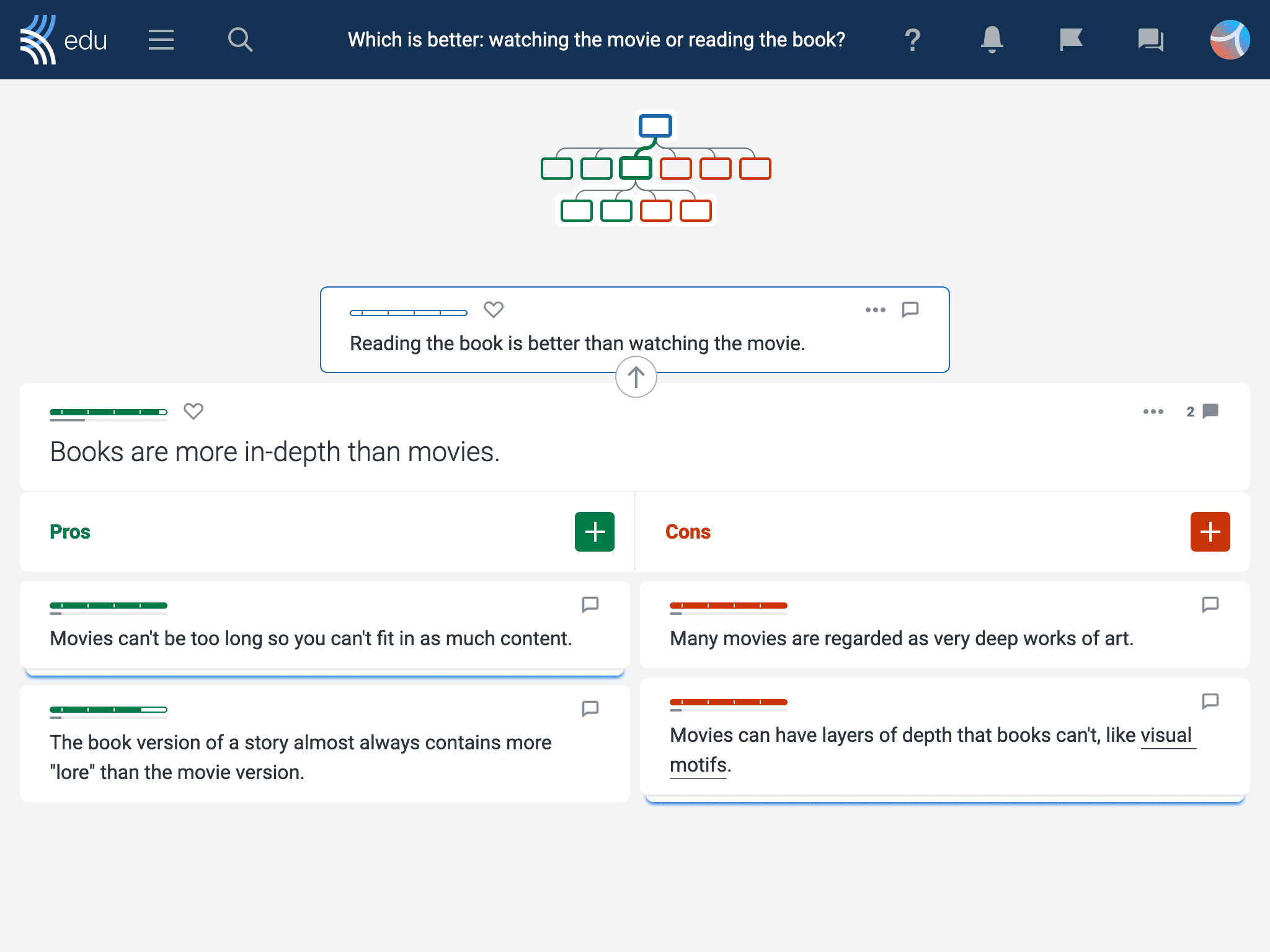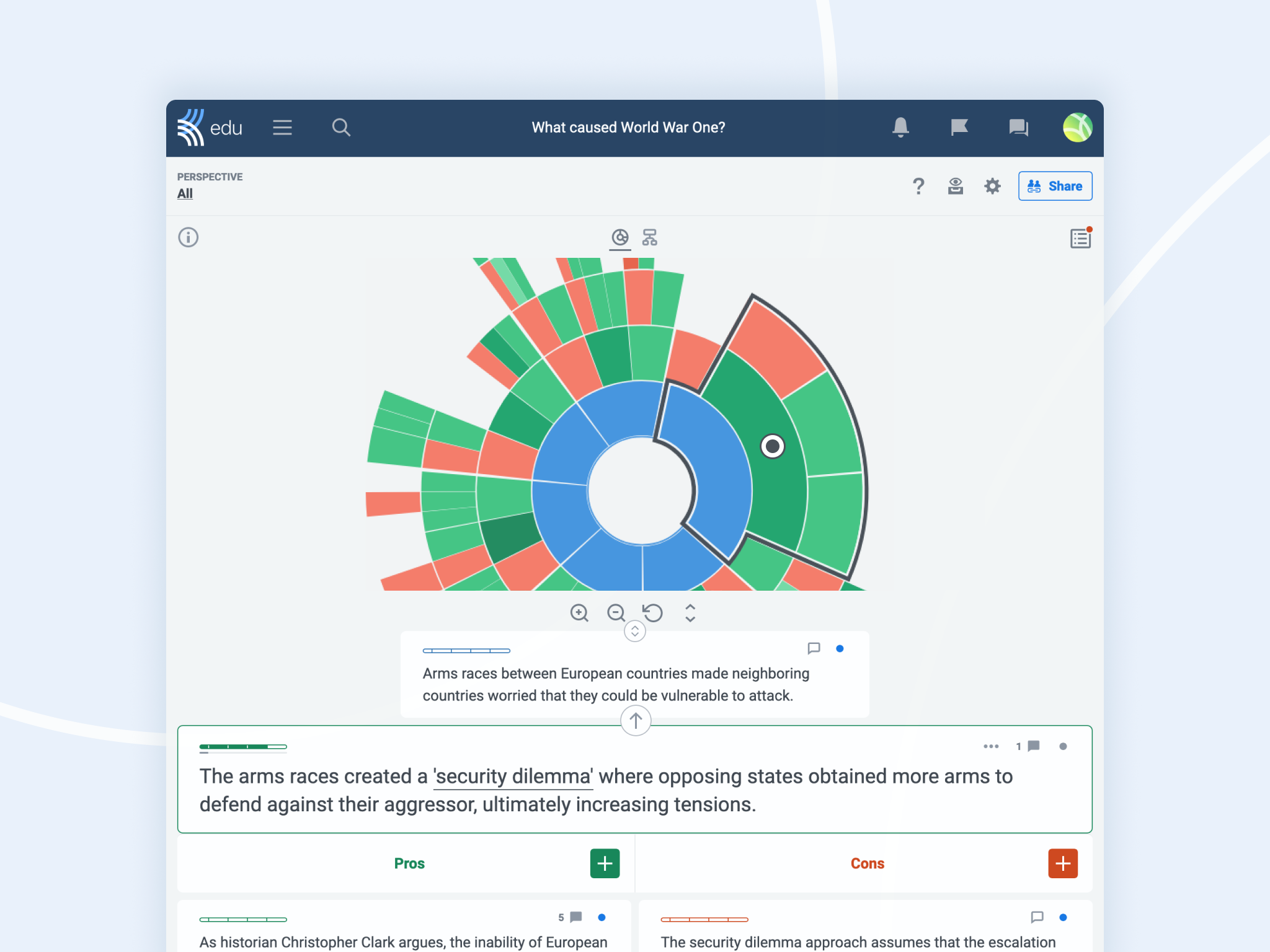Your students may shine in verbal discussions, but it can be more challenging for them to translate their ideas into a coherent argumentative essay. Fortunately, you can use Kialo free, adaptable written discussions to support students’ argumentative essay writing skills.
Kialo discussions guide students to clearly express viewpoints, address counterarguments, and provide compelling evidence. This sharpens students’ reasoning, argumentative, and critical thinking skills, empowering them to explore and defend complex issues through writing.
Let’s see how you can use Kialo discussions to enhance argumentative essay writing for your students!
How to choose a strong argumentative essay topic
Crafting a compelling argumentative essay begins with selecting the right topic. Follow the tips below to guide your students in making a strong selection.
1. Allow students to choose topics that interest them, especially topics relatable to their own experiences.
This will help boost students’ engagement with the essay, while their personal insights will add authenticity to their arguments.
2. Encourage students to select topics linked to current events or topical societal issues.
Such topics are more likely to capture interest, boosting audience engagement with the essay.
3. Remind students to select a topic with clear opposing viewpoints.
If viewpoints on a topic are already universally accepted, their essay may lack depth and purpose.
4. Give students time to conduct preliminary research.
This helps students find adequate evidence to support their arguments before finalizing their topic.
5. Help students choose strong argumentative essay topics with Kialo Edu’s Topic Library.
Our Topic Library is bursting with hundreds of relevant, engaging (and free!) argumentative essay ideas, organized by curriculum subject and age range.
How to write an argumentative essay on Kialo Edu
Students can practice writing their argumentative essays on Kialo. First, students should add a thesis statement. Then, students can write pro and con claims to develop lines of reasoning that act as supporting arguments while addressing counter arguments.

This mirrors a traditional essay format, where students present the thesis in the introduction and develop their arguments in the paragraphs of the body.
Let’s take a closer look at how each section in a traditional argumentative essay corresponds to parts of a Kialo discussion.
1. Traditional essay: Introduction
Kialo discussion: Thesis and Background Information
Students begin their argument by adding a thesis — a concise statement that articulates the main argument of the essay. Students could argue that Jane Eyre is a feminist novel, that water resources are a basic human right, or that religious faith is compatible with science.
They can also provide context in the Background Information to give an overview or abstract of their essay.

2. Traditional essay: Body paragraphs
Kialo discussion: Pro and con claims
Students use Kialo’s branching discussion framework to present the main arguments in support of their thesis. The visual discussion format reduces the cognitive load for students, freeing them up to concentrate on structuring their argument.
Students begin each branch with a top-level pro claim — the equivalent of a topic sentence — and then support this with further pro claims. The branching structure encourages students to make one claim at a time, directly addressing the previous point.
For those students who tend to overlook opposing perspectives, they can easily see both the supporting and opposing viewpoints that appear side by side in a Kialo discussion. This helps prompt students to consider and come up with counterarguments, as well as rebuttals to these counterarguments to further strengthen their main argument.

As students build their arguments, connective lines illustrate the logical relationships between each claim. This approach helps students understand how broader arguments are built on detailed evidence, enabling them to construct clear and precise arguments that develop specific lines of reasoning.
Finally, to help students avoid gaps in their reasoning, they can choose to view their argument in a unique “sunburst” mini-map, helping them identify knowledge gaps and thereby strengthening their argument.

3. Traditional essay: Conclusion
Kialo discussion: Collaborative evaluation
When students’ arguments reach their conclusion, the collaborative nature of Kialo discussions means students can progress beyond simply summarizing their claims.
Instead, students can vote on the impact of each other’s claims and add evaluative comments, while educators can provide Grading and Feedback on individual claims and the overall discussion. With comments and feedback that target specific claims, students can easily improve their arguments without engaging in extensive rewrites.
4. Traditional essay: References or bibliography
Throughout the discussion, students can strengthen claims by adding links to supporting evidence, including statistics, expert opinions, and real-world examples. This boosts the credibility of their claims and enables readers to verify the information.
Encourage students to add sources by enabling Tasks. You can specify the number of sources students must link to, tailoring the lesson to your learning objectives to monitor students’ progress.
And once students have completed their argument, they’ll find all their sources compiled into a reference list in the Sources sidebar!

Whether it’s selecting topics, writing arguments, or organizing sources, Kialo Edu’s free written discussion format will empower your students to excel in their argumentative essays. Get started today by signing up at Kialo Edu!
We’d love to hear how using Kialo has helped your students improve their argumentative essays. Contact us at feedback@kialo-edu.com or on social media.

